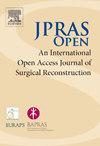Antibiotic prophylaxis for the prevention of fistulae in cleft palate repair: A quality improvement study
IF 1.5
Q3 SURGERY
引用次数: 0
Abstract
Background
Post-operative infection following cleft palate repair can lead to wound dehiscence and subsequent fistula formation. To prevent this, many surgeons advocate using post-operative antibiotic prophylaxis. The use of antibiotics in children is not without risks and with limited published data and variability both countrywide and in our unit, we wanted to address this research question.
Objective
To assess fistula rates and whether the provision of antibiotics post-operatively affected the incidence of oronasal fistula formation in patients with cleft palate.
Methodology
We performed an institutional retrospective study using data from patients undergoing primary palatoplasty between August 2021 and August 2022. These patients were divided into 2 groups. Group A included patients who received antibiotics only on induction and Group B additionally received post-operative antibiotic prophylaxis for 7 days. All participants (97) were evaluated for incidence of post-operative fistula formation.
Results
There was no evidence to suggest a difference in the fistula rate between the different timings of antibiotic regimen in Cycle 1; on induction + 2 intravenous doses (Group A) P = 0.807 and 7 days post-operatively (Group B) P = 0.820. Also, in cycle 2 there was no difference in the fistula rates between the 2 groups; P = 0.546 for Group A and P = 0.571 for Group B.
Conclusion
Our study suggests that the use of antibiotics post-operatively does not influence the formation of post-operative fistulae in cleft palate. This calls for a national randomised controlled study to answer this research question and achieve standardisation of practice.
求助全文
约1分钟内获得全文
求助全文
来源期刊

JPRAS Open
Medicine-Surgery
CiteScore
1.60
自引率
0.00%
发文量
89
审稿时长
22 weeks
期刊介绍:
JPRAS Open is an international, open access journal dedicated to publishing case reports, short communications, and full-length articles. JPRAS Open will provide the most current source of information and references in plastic, reconstructive & aesthetic surgery. The Journal is based on the continued need to improve surgical care by providing highlights in general reconstructive surgery; cleft lip, palate and craniofacial surgery; head and neck surgery; skin cancer; breast surgery; hand surgery; lower limb trauma; burns; and aesthetic surgery. The Journal will provide authors with fast publication times.
 求助内容:
求助内容: 应助结果提醒方式:
应助结果提醒方式:


